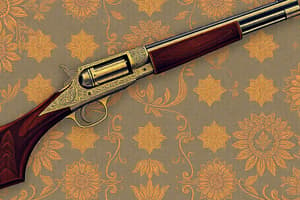Podcast
Questions and Answers
What is required of a permit holder regarding physical inventory of explosives?
What is required of a permit holder regarding physical inventory of explosives?
- At least one physical inventory quarterly
- At least one physical inventory annually (correct)
- No physical inventory is required
- At least two physical inventories annually
What information must be recorded by the next business day following the acquisition of explosive materials?
What information must be recorded by the next business day following the acquisition of explosive materials?
- The name and address of the manufacturer only
- Details of delivery personnel only
- A complete record including acquisition date, manufacturer name, quantity, and description (correct)
- Only the date and quantity of explosives
What details must licensed manufacturers include as marks of identification on explosive materials?
What details must licensed manufacturers include as marks of identification on explosive materials?
- Quantity produced and batch number
- Manufacturer's name and the color of the packaging
- Location, date, and shift of manufacture (correct)
- Only the manufacturer's name
What must a licensed importer indicate on explosive materials?
What must a licensed importer indicate on explosive materials?
What is the time frame for licensed importers to mark explosive materials after they are released from Customs custody?
What is the time frame for licensed importers to mark explosive materials after they are released from Customs custody?
What is the minimum required information on the record of disposition of explosive materials?
What is the minimum required information on the record of disposition of explosive materials?
Which of the following is NOT required to be recorded on the acquisition of explosive materials?
Which of the following is NOT required to be recorded on the acquisition of explosive materials?
If a manufacturer has only one shift during the day, what is required in their identification marks?
If a manufacturer has only one shift during the day, what is required in their identification marks?
What is the maximum time frame for a licensee or permittee to report a theft or loss of explosives after discovery?
What is the maximum time frame for a licensee or permittee to report a theft or loss of explosives after discovery?
Which ATF form must be completed and kept as a record when disposing of surplus explosive materials?
Which ATF form must be completed and kept as a record when disposing of surplus explosive materials?
What is the minimum retention period for records related to explosive materials transactions?
What is the minimum retention period for records related to explosive materials transactions?
What should be verified before a permittee disposes of surplus stock to another licensee?
What should be verified before a permittee disposes of surplus stock to another licensee?
What is the required notification time period for storing explosive materials to local fire authorities?
What is the required notification time period for storing explosive materials to local fire authorities?
Who may a licensee distribute explosive materials to?
Who may a licensee distribute explosive materials to?
Which document is NOT required when a distributor transfers possession of explosives to an employee of a carrier for transport?
Which document is NOT required when a distributor transfers possession of explosives to an employee of a carrier for transport?
How often must the inspection of explosives magazines be conducted?
How often must the inspection of explosives magazines be conducted?
What is the maximum quantity of explosive materials that can be stored in one magazine without special approval?
What is the maximum quantity of explosive materials that can be stored in one magazine without special approval?
Which of the following situations would prohibit a licensee from distributing explosives?
Which of the following situations would prohibit a licensee from distributing explosives?
What must be affixed to the Limited Permittee Transaction Report for distribution to a limited permit holder?
What must be affixed to the Limited Permittee Transaction Report for distribution to a limited permit holder?
What must be done prior to repairing explosives magazines?
What must be done prior to repairing explosives magazines?
Where must all electrical switches be located in explosives storage magazines?
Where must all electrical switches be located in explosives storage magazines?
What must a licensed dealer do if their license or permit contains an error?
What must a licensed dealer do if their license or permit contains an error?
Which of the following is exempt from the requirement to notify the ATF about changes in construction of a magazine?
Which of the following is exempt from the requirement to notify the ATF about changes in construction of a magazine?
Which of the following is required before releasing explosive materials to a new distributor?
Which of the following is required before releasing explosive materials to a new distributor?
What should a licensee do if they suspect a person intends to use explosives for unlawful purposes?
What should a licensee do if they suspect a person intends to use explosives for unlawful purposes?
What is required for plastic explosives shipped or transported after April 24, 1996?
What is required for plastic explosives shipped or transported after April 24, 1996?
Who has the right to enter and inspect explosives storage facilities during business hours?
Who has the right to enter and inspect explosives storage facilities during business hours?
What is needed to request a variance from federal explosive laws or regulations?
What is needed to request a variance from federal explosive laws or regulations?
What happens to permits and licenses once they have expired?
What happens to permits and licenses once they have expired?
What form must RP's and EP's fill out for background checks with the ATF?
What form must RP's and EP's fill out for background checks with the ATF?
Which of the following conditions does NOT apply to marking plastic explosives?
Which of the following conditions does NOT apply to marking plastic explosives?
What must a manufacturer certify when making a reproduction of their license or permit?
What must a manufacturer certify when making a reproduction of their license or permit?
What is the duration of an original license or permit for explosive materials?
What is the duration of an original license or permit for explosive materials?
What is the required action if a licensee intends to continue operations after the expiration of their license?
What is the required action if a licensee intends to continue operations after the expiration of their license?
Which type of explosive material is characterized as being able to detonate unconfined?
Which type of explosive material is characterized as being able to detonate unconfined?
Which type of magazine is a mobile facility used for the storage of high explosives?
Which type of magazine is a mobile facility used for the storage of high explosives?
What must be filed if a licensee misses the renewal deadline?
What must be filed if a licensee misses the renewal deadline?
How long is a limited permit issued for acquisitions?
How long is a limited permit issued for acquisitions?
Which type of magazine must be fire-resistant and weather-resistant?
Which type of magazine must be fire-resistant and weather-resistant?
What must happen within 30 days if an explosive materials business is discontinued?
What must happen within 30 days if an explosive materials business is discontinued?
Which option describes the construction of a Type 1 magazine?
Which option describes the construction of a Type 1 magazine?
What is a common storage requirement within type magazines?
What is a common storage requirement within type magazines?
What describes a Type 4 magazine?
What describes a Type 4 magazine?
Which type of explosive is characterized as being able to deflagrate when confined?
Which type of explosive is characterized as being able to deflagrate when confined?
What is required for tools used for opening containers of explosive materials?
What is required for tools used for opening containers of explosive materials?
Explosive materials should not interfere with which aspect while stored in magazines?
Explosive materials should not interfere with which aspect while stored in magazines?
Flashcards are hidden until you start studying
Study Notes
Federal Explosive Regulations Overview
- Permit holders must conduct at least one physical inventory annually and before/after transporting explosives.
- Required record-keeping for explosive acquisitions includes date, manufacturer details, quantity, and recipient's information.
- Disposition records need to be maintained by the next business day and include similar details as acquisitions.
Identification of Explosive Materials
- Licensed manufacturers and importers must mark explosives with their name, location, date, and shift of manufacture (if applicable).
- Licensed importers must mark imported explosives within 15 days of Customs release.
Daily Summary of Transactions
- Licensees must keep a daily summary record of transactions at each storage magazine.
- Summaries should include total quantities received and removed, and the remaining stock at the end of each day.
Reporting Theft or Loss of Explosives
- Theft or loss must be reported within 24 hours to the ATF and local law enforcement.
- Complete ATF Form 5400.5 for reporting, keeping a copy for records.
Record Retention Requirements
- All records must be retained for a minimum of five years.
Conduct of Business Rules
- Permittees may transfer surplus explosive materials to other licensed entities.
- Surplus can be disposed of within 45 days post-license expiration with prior verification of recipient authority.
Delivery and Acquisitions
- Delivery of explosives requires the ATF F 5400.8 record, except under specific transport conditions.
- Limited permit holders can acquire explosives but must present proper permits and identification.
Storage Regulations
- Explosive materials are classified into high explosives, low explosives, and blasting agents with specific storage requirements for each type.
- Magazines are categorized into Type 1 (permanent), Type 2 (mobile), Type 3 (portable), Type 4 (low explosives), and Type 5 (blasting agents).
Magazine Operational Standards
- Magazines must be constructed to be resistant to fire, theft, and weather, and must allow for proper ventilation.
- Storage rules mandate that they are clean, organized, and checked for compliance regularly (at least every 7 days).
Location and Proximity Regulations
- Magazines must be situated a specified minimum distance from inhabited buildings, public highways, railways, and other magazines.
Notifications and Changes
- Any storage of explosives must be reported to local fire authorities within stipulated timeframes.
- Changes to magazines or construction must be reported to the ATF, with a minimum three-day notice if written communication is used.
Lighting and Equipment Standards
- Battery-activated lights are permitted; all electrical installations must comply with the National Electrical Code for safety.
ATF Authority and Background Checks
- ATF officers are allowed to inspect records and facilities of licensees during business hours.
- Background checks and clearance are mandatory for Responsible Persons and Employee Possessors; ATF Form 5400.28 must be completed.
Plastic Explosive Regulations
- All plastic explosives must contain a detection agent, with certain exemptions for explosives manufactured before April 24, 1996.
Studying That Suits You
Use AI to generate personalized quizzes and flashcards to suit your learning preferences.




